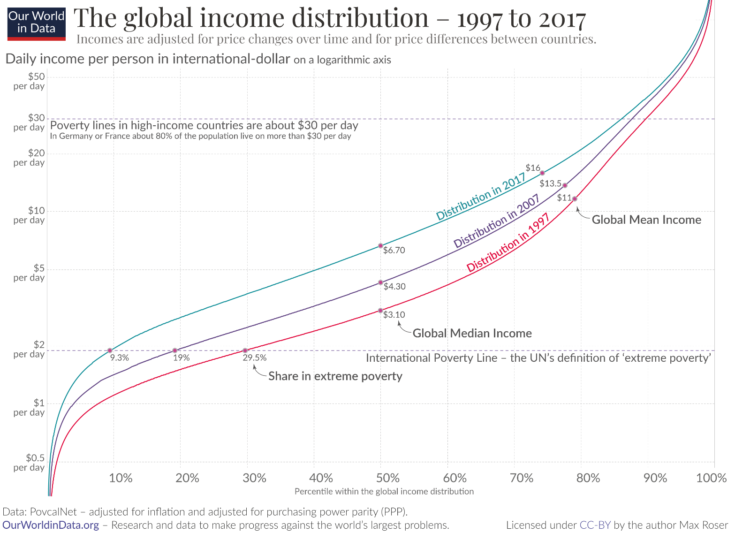
Suppose that like Rip van Winkle you fell asleep in 1997 and woke up in 2017. You asked a friend for a quick summary of what had occurred over the previous 20 years. A complete explanation would obviously take a long time, but this graph (tweeted by Max Roser) provides a very elegant summary of how the world has been progressing:

A few comments:
1. In principle, everyone over the age of 24 lies somewhere along each of those three lines. You might visualize most Chinese people as progressing up and to the right from the red line to the turquoise line.
2. The figures are adjusted for inflation and international cost of living differences. Those adjustments are far from perfect, but probably much better than not adjusting the figures. (Also note the log scale.)
3. The share living in “extreme poverty” has fallen from 29.5% to 9.3%. That’s pretty incredible, and is largely attributable to neoliberal reforms in places like China and India.
4. The share of the world living in poverty as defined in rich countries has fallen much more modestly, from about 90% to roughly 86% of the world’s population. Note how the number of poor people in the world is extremely sensitive to definitions.
5. The average (mean) income in the world is several times higher than the median income. That might be viewed as bad news. However the median income has been rising faster than the average income, which might be regarded as good news. So at least in the sense of the median/average gap, global income is becoming more equal.
6. Another way of making the same point is that over the 20 years from 1997 to 2017, poor and middle income areas of the world have made much more progress than rich areas. Bangladesh has grown a lot, Italy hardly at all.
PS. I wouldn’t take that $30/day poverty line for rich countries too literally. Obviously it depends on lots of factors. Thus a family of five making $50,000 is less poor than an individual making $10,000 due to certain economies of scale in housing expenses, auto transport, etc.
PPS. My grandmother’s maiden name was Clara van Winkle, which makes me a relative of Rip.

READER COMMENTS
Brandon Berg
Aug 14 2021 at 10:58am
Some additional observations:
1. Statistically, at least, progress has been slowed by the fact that fertility is higher in lower-income countries, while most rich countries have sub-replacement fertility. So the reduction in poverty for the world as a whole is less than the reduction in poverty within individual countries. I’m not sure how much we should care about this.
2. While the share of people living below the $30/day line has only modestly declined, the share living above it has increased by 40%, despite the aforementioned demographic headwinds.
Scott Sumner
Aug 15 2021 at 9:30am
Good points.
Allen Zhang
Aug 14 2021 at 3:30pm
Hi prof Sumner,
How does an increase in liquidy by the FED helps the stock market go up? The FED is buying bonds, mostly treasuries ….from investors? Investors are selling treasuries and buying stocks?
Michael Rulle
Aug 15 2021 at 9:07am
I have no reason to doubt the accuracy of these numbers; it fits my “common sense” view of things. Of course, this is global, although we know Italy has gone “nowhere”—-which fits my “common sense” view too.
For some reason there is a belief by many (at least what I read in much of the media) this has not occurred in the US—-certainly with median income growth. Others counter those stories exclude transfer payments and age adjustments, which this study does not mention.
It is interesting that something as seemingly straight forward as measuring income cannot be agreed upon. I assume it is not due to stupidity——but a willingness to mislead——or maybe both.
Scott Sumner
Aug 15 2021 at 9:28am
“It is interesting that something as seemingly straight forward as measuring income cannot be agreed upon. I assume it is not due to stupidity——but a willingness to mislead——or maybe both.”
What makes you think that measuring income is straightforward? It doesn’t seem at all straightforward to me.
Bob White
Aug 15 2021 at 10:42am
In fairness, Mr. Rulle did say “seemingly straightforward” to describe measuring income. This article and the comments demonstrate that it is more complex than that. It would be difficult to summarize the discussion in a soundbite (and those who try often intend to manipulate opinion, even if not outright mislead).
One of the refreshing things about this website is the effort that is made to declare biases and define terms and, in general, look at things from various angles.
Michael Rulle
Aug 20 2021 at 4:45pm
Hi Bob—Thanks for the “seemingly” (!). Okay, let’s say, per Scott, it is not “easy”. But one reads essays that use “households”, “per capita”, with or without “transfer payments”, “Gini Index”, “with age adjustment and without age adjustment”, with and without “investment earnings”, with and without counting h and many other features.
One might think this “does not make it at all straightforward”. But that is like saying financial accounting is not “straightforward”. Of course, relative to a normal smart reader it is not straightforward. But when one uses the term “straightforward” it should be clear it means relative to experts. And yes—-to be super precise even honest experts can disagree at the margins.
But it should be apparent that we have enough expertise at the various Fed Banks, Academic institutions, and private entities that complexity has generally been smoothed to the point where one should never have to read about “household income” —undefined—or read about quintile income—as if the same people are always in the same quintile —-etc., etc.,
So I do think it is “seemingly straightforward” for experts—–and Scott is aware that many essays are written designed to give a narrative rather than educate.
By the way—I like his chart—-at least it is per capita and adjusted for PPP—-pretty decent info for a small paragraph. And as far as I can tell, I see no narrative.
Billy Kaubashine
Aug 15 2021 at 10:17am
The first question that came to my mind was whether transfer payments were included in income measurements.
Minimal transfer payments can make a huge difference in low income countries.
In high income countries, income dependent transfer payments drive some recipients into “off the books” cash activity that doesn’t get measured.
Those same transfer payments allow other recipients to enjoy leisure with a subsistence level of income (the safety net becomes a hammock).
Spencer Bradley Hall
Aug 15 2021 at 10:49am
Link: “Shares of gross domestic income: compensation of employees, paid: wage and salary accruals: disbursements: to persons”
Shares of gross domestic income: Compensation of employees, paid: Wage and salary accruals: Disbursements: to persons (W270RE1A156NBEA) | FRED | St. Louis Fed (stlouisfed.org)
Comments are closed.